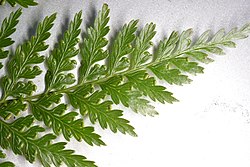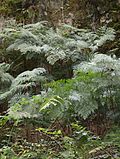| Culcita | |
|---|---|
 | |
| Culcita macrocarpa | |
| Scientific classification | |
| Kingdom: | Plantae |
| Clade: | Tracheophytes |
| Division: | Polypodiophyta |
| Class: | Polypodiopsida |
| Order: | Cyatheales |
| Family: | Culcitaceae Pic.Serm. |
| Genus: | Culcita C.Presl |
| Type species | |
| Culcita macrocarpa | |
| Species | |
| |
Culcita is a genus of ferns, native to the Americas, Macaronesia and Iberian Peninsula. It is the only genus in the family Culcitaceae in the Pteridophyte Phylogeny Group classification of 2016 (PPG I). [1] Alternatively, the family may be treated as the subfamily Culcitoideae of a very broadly defined family Cyatheaceae, [2] the placement used for the genus in Plants of the World Online as of November 2019 [update] . [3]

